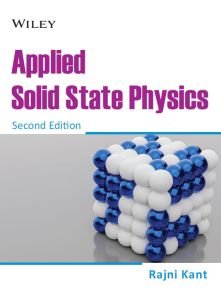Applied Solid State Physics, 2ed
ISBN: 9789354643309
Publication Year: 2022
For more information write to us at: acadmktg@wiley.com

Description
The book covers all major aspects of the science of crystals. The approach of the book is unique because it offers thought-provoking ideas about the Physics of Solids, rather than being merely a compilation of research data and statistical figures. The learning design has been presented in such a way that the students at the undergraduate and postgraduate levels, including the researchers in materials science, get an exposition of the fundamentals and the application potential of crystals' physics. The understanding of the basics is supplemented and supported by a strong mathematical basis and reasoning.
1 Crystals, Lattices and Symmetry
1.1 Introduction
1.2 The Crystal Lattice and Unit Cell
1.3 The Bravais Lattices
1.4 Symmetry in Solids
1.5 Miller Indices
1.6 Point Groups (Crystal-Class) Symmetry
1.7 Space Groups
1.8 Crystal Structure: Lattice with a Basis
1.9 Some Typical Crystal Structures
1.10 Solved Examples
2 Bonding in Solids
2.1 Introduction
2.2 How do the Atoms in a Solid Interact?
2.3 Ionic Bonding
2.4 Covalent Bonding
2.5 Metallic Bonding
2.6 Comparison between Ionic and Covalent Bonding
2.7 Comparison between Ionic and Metallic Bonding
2.8 Hydrogen Bonding: What is it and How it Occurs
2.9 Properties of Hydrogen Bonding
2.10 van der Waals Bonding
2.11 Solved Examples
3 X-rays: Concept, Properties and Reciprocal Lattice
3.1 Introduction
3.2 Production of X-rays
3.3 Types of X-ray Tubes
3.4 Absorption of X-rays
3.5 Absorption Spectra and Filtering
3.6 Selection of Radiation
3.7 Laue’s Concept of X-ray Diffraction
3.8 Bragg’s Concept of X-ray Diffraction
3.9 Proof of Bragg’s Equation
3.10 Applications of X-rays
3.11 What Makes X-radiation a Dangerous Phenomenon?
3.12 Some Uses of X-ray Diffraction
3.13 The Reciprocal Lattice
3.14 Properties of Reciprocal Lattice
3.15 Bragg’s Law in Reciprocal Space
3.16 Neutron Diffraction
3.17 Electron Diffraction
3.18 Solved Examples
4 Relating Atomic Structure to Some Physical Properties
4.1 Introduction
4.2 Crystallization: General Principle
4.3 Growing Crystals from Solution
4.4 Isomorphs and Polymorphs
4.5 Allotropic Phase Transitions: Changing the Crystal Structure
4.6 Enantiomorphs and Racemates
4.7 Crystal Habit
4.8 Sampling and Crystal Mounting
4.9 Collimation of the Incident X-ray Beam
4.10 Calculating Crystal Density by Floatation Method
4.11 Solved Examples
5 Experimental X-ray Diffraction Techniques
5.1 Introduction
5.2 The Laue Method
5.3 The Divergent-beam Method
5.4 The Oscillation/Rotation Method
5.5 The Weissenberg Method
5.6 The Precession Method
5.7 Computer-controlled Single Crystal X-ray Diffractometer
5.8 X-ray Diffraction with a Polycrystalline Material
5.9 Computer-controlled Powder X-ray Diffractometer
5.10 Solved Examples
6 Structure Factor and Fourier Synthesis
6.1 Introduction
6.2 The Atomic Scattering Factor
6.3 The Structure Factor
6.4 Fourier Synthesis
6.5 The Effect of Pseudosymmetry on Structure Factor Distribution
6.6 Solved Examples
7 Techniques of X-ray Structure Determination
7.1 Introduction
7.2 The Phase Problem
7.3 Isomorphous Replacement Technique
7.4 The Vector Technique
7.5 The Trial-and-Error Method
7.6 The Direct Methods
7.7 Methods of Structure Refinement
7.8 Derived Results: Geometrical Parameters
7.9 Solved Examples
8 Crystal Imperfections: Their Classification and Characterization
8.1 Introduction
8.2 Imperfections in Solids
8.3 Line Imperfections
8.4 Surface (Plane) Defects
8.5 Etching Techniques For Dislocation Characterization
8.6 X-ray Topographic Techniques for Dislocation Characterization
8.7 Electron Microscope in Materials Characterization
8.8 Scanning Electron Microscope (SEM)
8.9 Transmission Electron Microscope (TEM)
8.10 Solved Examples
9 Lattice Dynamics and Thermal Properties of Solids
9.1 Introduction
9.2 Lattice (Atomic) Vibrations
9.3 Lattice Vibrations in a One-dimensional Monoatomic Chain
9.4 Lattice Vibrations in a Diatomic Linear Chain
9.5 Measurement of Dispersion Relation
9.6 Quantization of Lattice Vibrations: Concept of Phonons
9.7 Thermal Properties of Solids
9.8 Anharmonic Crystal Interactions
9.9 Normal and Umklapp Processes
9.10 Solved Examples
10 An Introduction to Quantum Physics
10.1 Historical Perspective
10.2 Inadequacies of Classical Physics
10.3 Photoelectric Effect
10.4 de Broglie’s Hypothesis of Matter Waves
10.5 Davisson–Germer Experiment
10.6 Waves of Probability
10.7 Mathematical Description of a Wave
10.8 Schrödinger Wave Equation
10.9 Particle in a Box
10.10 The Uncertainty Principle
10.11 Solved Examples
11 The Fermi Surface and Fermi Gas
11.1 Definition
11.2 Brillouin Zones
11.3 The Fermi Surface in Metals
11.4 Measurement of Fermi Surface Shapes and Dimensions
12 Electrons in Solids
12.1 Introduction
12.2 Classical Models: An Overview
12.3 Some General Properties of Metals
12.4 Electrical Conductivity in Metals
12.5 The Matthiesen’s Rule
12.6 Electron Motion: Boltzmann Equation and Relaxation Time
12.7 The Drude’s Model
12.8 The Quantized Free Electron Theory (Fermi–Dirac Statistics of Electron Gas)
12.9 Specific Heat of a Degenerate Electron Gas
12.10 Thermal Conduction
12.11 The Wiedemann–Franz Ratio
12.12 Solved Examples
13 The Band Theory of Solids
13.1 Introduction
13.2 Bloch’s Quantum Theory of Electrical Conduction
13.3 Energy Levels in Solids
13.4 Energy Bands in Solids (The Bloch Theorem)
13.5 Electron in a Periodic Potential (The Kronig–Penney Model)
13.6 Electron Velocity (as per Band Theory)
13.7 Electron’s Effective Mass (as per Band Theory)
13.8 Classification of Crystalline Solids
13.9 Solved Examples
14 Magnetic Properties of Solids
14.1 Historical Perspective and Review of Some Basics
14.2 The Origin of Permanent Magnetic Dipoles
14.3 The Larmor’s Precession
14.4 Classification of Magnetic Materials
14.5 Diamagnetism (Langevin’s Theory)
14.6 Paramagnetism
14.7 Ferromagnetism
14.8 Origin (Theory) of Domains
14.9 Magnetic Hysteresis
14.10 Soft Magnetic Materials
14.11 Hard Magnetic Materials
15 Dielectric Properties
15.1 Introduction
15.2 Dielectric Constant and Susceptibility
15.3 Factors Affecting Dielectric Constant
15.4 Induced Polarization
15.5 Internal Fields in Solids
15.6 Clausius–Mossotti Relationship
15.7 Sources of Polarizability
15.8 Dielectric Breakdown
15.9 Piezoelectricity
15.10 Ferroelectricity
15.11 Ferroelectrics: Potential Areas of Applications
15.12 Solved Examples
16 Semiconductors: Theory and Devices
16.1 Introduction
16.2 Conduction in Semiconductors
16.3 Intrinsic Semiconductors
16.4 Carrier Concentration in Intrinsic Semiconductors
16.5 Extrinsic Semiconductors
16.6 Motion of Carriers in Electric and Magnetic Fields
16.7 Carrier Diffusion: Einstein Relation
16.8 Semiconductor Devices
16.9 The Transistor
16.10 Solved Examples
17 Superconductivity
17.1 Superconductivity – The Phenomenon
17.2 Basic Properties of Superconductors
17.3 Thermodynamic Aspects
17.4 London Phenomenology
17.5 BCS Theory of Superconductivity
17.6 The Josephson Effect
17.7 High Temperature Superconductors
17.8 Some Applications of Superconductivity

